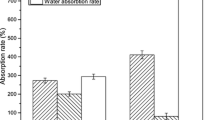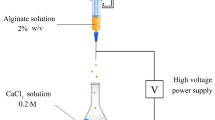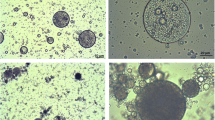Abstract
The combination of bioaugmentation and biostimulation was used to speed up the bioremediation of marine oil spills. A novel carrier material that consisted of puffed panicum miliaceum (PPM), calcium alginate and chitosan was prepared. The porous structure and low density of PPM ensured this carrier material not only had appropriate physical and biological properties for the aggregation of microorganisms but also was biodegradable and floating on the seawater surface for bioremediation of oil pollution. An oil-degrading bacterial consortium was immobilized via adsorption on the carrier material. The immobilized bacteria were observed with scanning electron microscopy. The number of viable cells immobilized on the material was approximately 1.12 × 108 CFU/g. To solve the problem of nutrients supplementation in seawater, an emulsion formed with urea solution, soybean lecithin, alcohol and oleic acid was prepared as oleophilic fertilizer. The results from laboratory and field mesocosm experiments showed that the combination of immobilized bacteria and the emulsion achieved a higher oil removal efficiency compared with the use of them separately. The results of field mesocosm experiments conducted in the coastal seawater showed that most of the petroleum pollutant (> 98%) was removed from the surface of seawater in 24 h. GC–MS analysis showed that most components of petroleum pollutants had been removed. This formula with immobilized bacteria and emulsion can be exploited further for the bioremediation of marine oil spills.








Similar content being viewed by others
Data availability
The datasets used or analysed during the current study are available from the corresponding author on reasonable request.
Code availability
Not applicable.
References
Bachmann RT, Johnson AC, Edyvean RG (2014) Biotechnology in the petroleum industry: an overview. Int Biodeterior Biodegradation 86:225–237
Baek KH, Yoon BD, Kim BH et al (2007) Monitoring of microbial diversity and activity during bioremediation of crude OH-contaminated soil with different treatments. J Microbiol Biotechnol 17:67–73
Button DK, Robertson BR, McIntosh D et al (1992) Interactions between marine bacteria and dissolved-phase and beached hydrocarbons after the Exxon Valdez oil spill. Appl Environ Microbiol 58:243–251
Das N, Chandran P (2011) Microbial degradation of petroleum hydrocarbon contaminants: an overview. Biotechnol Res Int. https://doi.org/10.4061/2011/941810
Gertler C, Bargiela R, Mapelli F et al (2015) Conversion of uric acid into ammonium in oil-degrading marine microbial communities: a possible role of Halomonads. Microb Ecol 70:724–740
Gallego JR, Fernandez JR, Diez-Sanz F et al (2007) Bioremediation for shoreline cleanup: in situ vs. on-site treatments. Environ Eng Sci 24:493–504
Knezevich V, Koren O, Ron EZ et al (2006) Petroleum bioremediation in seawater using guano as the fertilizer. Bioremediat J 10:83–91
Ko JY, Day JW (2005) A review of ecological impacts of oil and gas development on coastal ecosystems in the Mississippi Delta. Ocean Coast Manag 47:597–623
Luo Q, He Y, Hou DY et al (2015) GPo1 alkB gene expression for improvement of the degradation of diesel oil by a bacterial consortium. Braz J Microbiol 46:649–657
Luo Q, Zhang JG, Shen XR et al (2013) Isolation and characterization of marine diesel oil-degrading Acinetobacter sp. strain Y2. Ann Microbiol 63:633–640
Ma P, Xin YR, Yang JY et al (2001) Determination of emulsion stability by centrifugation and Spectrophotometry. J Pharm Pract 01:23 ((Chinese))
Nikolopoulou M, Kalogerakis N (2008) Enhanced bioremediation of crude oil utilizing lipophilic fertilizers combined with biosurfactants and molasses. Mar Pollut Bull 56:1855–1861
Quek E, Ting YP, Tan HM (2006) Rhodococcus sp. F92 immobilized on polyurethane foam shows ability to degrade various petroleum products. Biores Technol 97:32–38
Obuekwe CO, Muttawa EA (2001) Self-immobilized bacterial cultures with potential for application as ready-to-use seeds for petroleum bioremediation. Biotech Lett 23:1025–1032
Parach A, Rezvani A, Assadi MM et al (2017) Biodegradation of Heavy Crude Oil Using Persian Gulf Autochthonous Bacterium. Int J Environ Res 11:667–675
Pasumarthi R, Chandrasekaran S, Mutnuri S (2013) Biodegradation of crude oil by Pseudomonas aeruginosa and Escherichia fergusonii isolated from the Goan coast. Mar Pollut Bull 76:276–282
Pritchard PH, Mueller JG, Rogers JC et al (1992) Oil spill bioremediation: experiences, lessons and results from the Exxon Valdez oil spill in Alaska. Biodegradation 3:315–335
Prince RC, Atlas RM (2005) Bioremediation of marine oil spills. In: Atlas RM, Philp JC (eds) Bioremediation: applied microbial solutions for real-world environmental cleanup. ASM Press, Washington, DC, pp 269–292
Ron E, Rosenber E (2010) Role of Fertilizers Biostimulation. In: Timmis KN (ed) Handbook of Hydrocarbon and Lipid Microbiology. Springer, Berlin, pp 2501–2504
Roostan Z, Safahieh A, Mojodi F et al (2012) Phenanthrene biodegradation by Pseudomonas aeruginosa and Bacillus subtilis isolated from Persian Gulf sediments. Afr J Microbiol Res 6:4585–4591
Safdari MS, Kariminia HR, Nejad ZG et al (2017) Study Potential of Indigenous Pseudomonas aeruginosa and Bacillus subtilis in Bioremediation of Diesel-Contaminated Water. Water Air Soil Pollut 228:37
Swannell RPJ, Lee K, McDonagh M (1996) Field evaluations of marine oil spill bioremediation. Microbiol Mol Biol Rev 60:342–365
Xia WX, Li JC, Zheng XL et al (2006) Enhanced biodegradation of diesel oil in seawater supplemented with nutrients. Eng Life Sci 6:80–85
Xue J, Yu Y, Bai Y et al (2015) Marine Oil-Degrading Microorganisms and Biodegradation Process of Petroleum Hydrocarbon in Marine Environments: A Review. Curr Microbiol 71:220–228
Zhang Y, Gao W, Lin Y et al (2018) Study on immobilization of marine oil-degrading bacteria by carrier of algae materials. World J Microbiol Biotechnol 34:70
Zhang G, Liao Q, Wang Y (2011) Research progress in immobilized microorganisms carrier material. Mat Rev 25:105–109
Zheng GY, Selvam A, Wong JWC (2012) Oil-in-water microemulsions enhance the biodegradation of DDT by Phanerochaete chrysosporium. Biores Technol 126:397–403
Zhu X, Venosa AD, Suidan MT et al (2001) Guidelines for the bioremediation of marine shorelines and freshwater wetlands. US Environmental Protection Agency, Cincinnati, OH
Acknowledgements
This work was supported by NSFC-Zhejiang Joint Fund for Integration of Industrialization and Diversification (Grant No. U1809214).
Funding
This work was supported by NSFC-Zhejiang Joint Fund for Integration of Industrialization and Diversification (Grant No. U1809214).
Author information
Authors and Affiliations
Contributions
All authors contributed to the study conception and design. Material preparation, data collection and analysis were performed by [Qun Luo], [Dengyong Hou], [Dingwen Jiang] and [Wei Chen]. The first draft of the manuscript was written by [Qun Luo] and all authors commented on previous versions of the manuscript. All authors read and approved the final manuscript.
Corresponding author
Ethics declarations
Conflict of interest
The authors declare that they have no conflict of interest.
Additional information
Publisher's Note
Springer Nature remains neutral with regard to jurisdictional claims in published maps and institutional affiliations.
Rights and permissions
About this article
Cite this article
Luo, Q., Hou, D., Jiang, D. et al. Bioremediation of marine oil spills by immobilized oil-degrading bacteria and nutrition emulsion. Biodegradation 32, 165–177 (2021). https://doi.org/10.1007/s10532-021-09930-5
Received:
Accepted:
Published:
Issue Date:
DOI: https://doi.org/10.1007/s10532-021-09930-5




